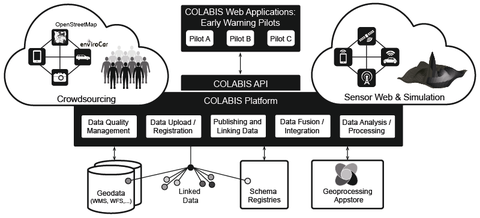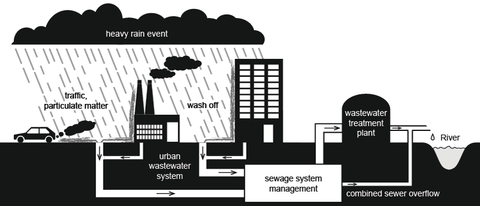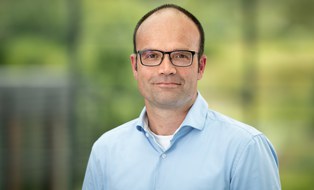COLABIS
(Collaborative Early Warning Information Systems for Urban Infrastructures)
Inhaltsverzeichnis
About COLABIS
COLABIS will design and implement a Web platform that enables and eases the development of urban early warning systems, specifically focusing on information fusion derived from sensors, crowdsourcing, geosimulations, as well as administrative and historical data. The project focusses on local heavy rain, flooding and cascading events affecting urban water and sewage infrastructures but also traffic infrastructures. Pilot applications serve as proof-of-concepts and help to develop best practices. To support decision makers with timely and value added information, input data from various sources need to be combined. This data fusion comprises data retrieval, enhancement, harmonization, similarity measures, matching, conflict detection and resolving. The consistency and reliability of results essentially relies on the underlying data quality, which varies over the different data sources. Therefore, quality metrics will play a major role in COLABIS.

Architecture sketch of the COLABIS platform
The city of Dresden will be the project’s pilot area. Findings from the BMBF-funded project REGKLAM indicate an increasing risk of local heavy rain events in the Dresden area, especially during summer seasons. These heavy rain events paired with previous dry seasons are expected to extremely stress the Dresden sewer system and provoke serious surcharges and local floods with cascading effects on the urban environment and the urban infrastructure. In this context COLABIS will develop a decision support platform for environmental agencies and sewage management companies to
- better monitor, model and predict combined wastewater quantities,
- better assess its pollution levels during heavy and moderate rainfall events, and
- support the related decisions which water to retain, to discharge or treat right away.
The monitoring will be supported by modern sensor technology and crowdsourced data. The potential of the newly developed approaches to assess water pollutant levels will get evaluated using simulation-based techniques and data about historical events.
For pilot use cases, the Stadtentwässerung Dresden GmbH - one of the COLABIS stakeholders - represents the local sewage management company. Environmental agencies are represented by the Saxon State Office for Environment, Agriculture and Geology.
In Dresden, as in most German cities, combined sewer systems are in use, which mix sewage and stormwater to combined wastewater. In the event of heavy rains the capacities of the urban sewage plants are often insufficient to treat the total combined wastewater influx. In this case, to protect the sewage plant from overloading, water will also be discharged as diluted, but untreated sewage (e.g. into the river Elbe in Dresden) after the combined water storage volumes are exhausted (cf. figure below). This concept is known as combined sewer overflow (CSO). In controlled systems, the overflow is minimised by temporary storing combined water either in storage tanks or in large sewers which are not yet used to their full capacity. Though this approach reduces untreated combined water outflow, it is not ideal in regard to minimizing water pollution and reducing threats to the environment. As in some scenarios the retention storage will be filled with less polluted combined water (e.g. during night time) instead of the following, potentially higher polluted water (e.g. early in the morning). Depending on the sewage and rain water sources, the time of day, the duration of the preceding dry period and the course of the rain event, the pollution of the combined wastewater differs highly dynamically during the course of the event.

Overview on the COLABIS case study.
As it is the objective of the sewage system management to minimize water pollution, it should release less polluted water as combined wastewater overflow and direct the higher polluted water directly to the sewage plant or delay treatment by using less filled sewage tunnels as retention storages. Controlling about which water to be treated and which water to be discharged without treatment is currently limited. To enable a more efficient control – being based on the present level of pollution in the water – the sewage system has to act anticipatorily and not just react to the present level of water pollution.
To meet these requirements, a variety of data from different sources has to be collected and fused to enhanced information. Currently, there is a lack particularly in terms of monitoring and modelling of spatial and temporal information about stormwater and combined wastewater pollution. The spatio-temporal resolution of pollutant deposition differs by source (traffic, industry and washouts e.g. from buildings), and the knowledge about extent and dynamics of surface erosions of different pollutants is insufficient. To estimate retention effects in dependence of rain events of the immediate past, evaporation and exact surface structures of catchment areas are key factors to deduce the fill factor of water pools (like puddles, irregularities and gaps on the surface) to start the rainfall discharge modelling.
Traffic causes pollutant deposition on the road surface, e.g. by tire abrasion, brake pad abrasion (mainly copper and cadmium) and particulate matter, which will end up in the sewage system after rain events. Another source for rain water pollutants are dissolved tin and copper from roofs, eaves and down pipes, and washed off fungicides from storefronts. Further, sewage changes its composition throughout the day almost systematically and adds to the pollution of the combined wastewater. In addition to organic input and nutrient matter, sewage contains increasing amounts of anthropogenic micro pollutants.
The Dresden wastewater system is particularly suitable for the investigations, since it exhibits a good potential for monitoring and control. The Dresden sewer system has a total length of 1730 km, including combined as well as sewage and stormwater sewers. Rain intensities are measured with 20 rain gauges in 5 minutes time steps, allowing for a decent resolution of rain patterns in space and time. Some 60 water level and velocity on-line sensors are distributed in the total sewer system and at ten sites devices can be activated for event-dependent control of the runoff process. With some 80 pumping stations and five retention tanks further options for monitoring and control are available.
Apart from the sewer system monitoring, COLABIS can also built on the traffic management system VAMOS which provides a comprehensive overview on the traffic situation of the city of Dresden. Information is derived from observations of different kinds of mobile and in-situ sensors. One important source of traffic data are Floating Car Data (FCD) which are collected by more than 500 taxicabs, operated by the Dresden taxicab cooperative. By sending their position information every 5 seconds, they cover a big part of the road network and can be used to derive information about traffic density and traffic behaviour as a source to derive related pollution and depositions. The information will be further enriched by usage of a recently developed low cost in-car sensor system (enviroCar) to also include crowdsourced observations. In return early warnings generated in COLABIS applications can be issued via VAMOS, for instance to inform about blocked roads or to redirect major traffic streams by use of modern traffic signs.
Duration:
The project started on 1 June 2015 and will run for 3 years.
Grant agreement no:
03G0852A
Project Partners
Chair of Geoinformatics
The Technische Universität Dresden (TUD) is one of eleven German universities that were identified as an "excellence university" and is the largest university in the federal state Saxony. The Chair of Geoinformatics (TUD-GI) acts cross-cutting at the Department of Geosciences, within the Faculty of Environmental Sciences at TUD. The TUD-GI team currently consists of more than ten research associates and post doc researchers from different disciplines (Geodesy, Geography, Geoinformatics, Informatics). Research and Education focuses on various topics within Geoinformation Science and here especially on Geoinformation Infrastructures and Services for Spatio-Temporal Modeling. The team is represented in the council of AGILE, chairs Chair of Commission 5 Network Services in EuroSDR, is OGC member and serves numerous scientific boards. TUD-GI is an associate partner of the 52°North Initiative for Geospatial Open Source Software. The TUD-GI team successfully managed and co-managed national and international third party funded research projects.
Find more under https://tu-dresden.de/bu/umwelt/geo/geoinformatik.
Role in COLABIS: The TUD-GI team will coordinate the COLABIS project. The main management tasks are given by SP 1 (coordination, outreach, and exploitation planning). Beside the project coordination, TUD-GI will mainly contribute to SP 2 and SP 3 and specifically focus on research and developments to enhance geodata fusion, distributed geoprocessing, and quality descriptions for (crowdsourced) geodata. TUD-GI will contribute to all three pilots.
Chair of Urban Water Management
The Chair of Urban Water Management (TUD-UWM) is part of the Faculty of Environmental Sciences at TUD. The chair of Urban water Management includes some 20 scientists and is dealing with integrated modelling, operation and optimisation of the wastewater system, including the rain-runoff-process in the urban catchment, the runoff process in the sewer system, the wastewater treatment processes as well as the transport and conversion processes in the receiving water. Later developments were concerning the interaction between leaky sewer systems and the groundwater aquifer, the generation of sewer systems in order to carry out numerical simulations when information is scarce, and generally to build a link to large scale river basin management as in present flux model analysis the significance of the urban region for the coupling of water and matter fluxes is underestimated. In the recent past, the TUD-UWM was coordinating co-operative EU and BMBF projects, and was successfully carrying out some projects more oriented towards fundamental research, funded by DFG.
Find more under: http://www.tu-dresden.de/fghhisi/.
Role in COLABIS: TUD-UWM will be responsible for the development concerning the wastewater system. Pollutants sources are identified, where necessary described dynamically, and are linked to rain information. Using these as model inputs, runoff and pollutants transport simulation is then used a basis for the development of an early warning system together with TUD-GIS. TUD-SWW will contribute to all three pilots.
Chair for Traffic Control Systems and Process Automation
The "Friedrich List" faculty for Transportation and Traffic Sciences at TUD is the only dedicated transport faculty in Germany. It is the renowned centre of excellence for all fields of transportation research and has participated in a number of EC funded and national research projects. The Chair for Traffic Control Systems and Process Automation (TUD-TCS) deals with the development and application of methods of control engineering, computer science, operations research and telecommunication in the field of transportation with a focus on ground transportation modes. In research and development projects road traffic, public transport systems and railway systems are regarded, sometimes in an inter-modal way. The main areas of expertise are traffic management, traffic control strategies, data analysis, traffic information systems, driver advisory and information systems and the evaluation of Intelligent Transportation Systems (ITS) applications.
Find more under http://tu-dresden.de/die_tu_dresden/fakultaeten/vkw/vis/vlp.
Role in COLABIS: The TUD-TCS team will primarily develop the case study and pilot on road traffic analysis and management (SP 3). Available FCD for the city of Dresden as well as current traffic volume counts will be used as additional input for COLABIS in terms of pollutant deposition. VAMOS will be used to distribute COLABIS information in the transport sector. Thus, TUD-TCS will contribute to Pilot 1 and Pilot 3.
52°North - Initiative for Geospatial Open Source Software GmbH
The Open Source geospatial software initiative 52°North (52N) is an open international network of partners from research, industry and public administration. Its main purpose is to foster innovation in the field of Geoinformatics through a collaborative R&D process. The 52°North R&D communities develop new concepts and technologies e.g. for managing near real-time sensor data, integrating geoprocessing technologies into GDIs, making use of Cloud technologies, supporting and managing Citizen Science data, and Web of Things technology. The 52N GmbH is the initiative’s administrative office and service centre. It functions as initiator and contributor in many of the network’s activities. The 52N team of IT experts maintains the Open Source software repositories, provides its partners with an extensive IT and communication infrastructure to support the collaborative software development process and is strongly involved in research as well as software development/consulting projects that form an important foundation of the 52N community activities.
Find more under http://52north.org/.
Role in COLABIS: The 52N team will participate in SP 1 through requirements discussion and scenario definition as a basis for pilots’ development. The 52N team will mainly contribute to SP 2, the COLABIS platform, its architectural design and implementations and specifically focus on research and developments to enhance linking crowdsourcing and the Sensor Web. 52N will contribute to Pilot 1 and Pilot 3.
Fraunhofer Institute for Computer Graphics Research
The Fraunhofer Institute for Computer Graphics Research (IGD) is the world's leading institute for applied research in the field of visual computing. The research and development projects of IGD are directly related to current requirements of market and economy. Currently, it has about 180 employees. The department Spatial Information Management focuses on research topics related to semantic information management and spatial information visualisation within Spatial Data Infrastructures and 3D GIS. The goal of this group is to increase the use and usability of spatial information. IGD is a technical OGC member and the IGD team is active in the standardization processes in the area of geospatial web processing, geospatial semantics, and 3D portrayal. The department was co-founder of the InGeoForum and the Data Harmonisation Panel and is member of AGILE.
Find more under
http://www.igd.fraunhofer.de/en/Institut/Abteilungen/Geoinformationsmanagement.
Role in COLABIS: The IGD team will participate in SP 1 through requirements discussion and scenario definition as a basis for pilots’ development. IGD mainly contributes in SP 2 into the architectural design and implementation of the COLABIS platform with a scientific focus on collaborative data transformation, semantic annotation of geospatial data sources and creating and exploiting Linked Geospatial Data. In SP 3 IGD supports integration of 3 dimensional geospatial data facilitating the early warning models. IGD will contribute to Pilot 1 and Pilot 2.
Project Coordinator
Chair of Geoinformatics
Faculty of Environmental Sciences
Technische Universität Dresden
 © Robert Lohse
© Robert Lohse
Professor
NameProf. Dr. Lars Bernard
Eine verschlüsselte E-Mail über das SecureMail-Portal versenden (nur für TUD-externe Personen).
Besucheradresse:
Hülssebau, HÜL O161 Helmholtzstraße 10
01069 Dresden
Deutschland
Publications
2018
Mäs, S.; Henzen, D. and Bernard, L. (2018): Getting closer to the researcher‘s desk – from acquisition and management to publishing scientific data. Open Science Conference, 19-20 March 2018
Sadeghikhah, A.; Zhang, J. and Krebs, P. (2018): Modelling of heavy metals and PAHs concentration in urban stormwater runoff. 11th International Conference on Urban Drainage Modelling, Palermo, Italy.
Mäs, S.; Henzen, D.; Jirka, S.; Bernard, L. and Rieke, M. (2018): A research data management platform to support the daily tasks of environmental researchers. European Geosciences Union General Assembly 2018
Mäs, S.; Henzen, D.; Jirka, S.; Senner, I. (2018): Generic schema descriptions for comma-separated values files of environmental data. 21st AGILE Conference on Geo-information science, Lund, Sweden
2017
Kaeseberg, T.; Kaeseberg, M. and Krebs, P. (2017): Improved calibration of diurnal dry weather flow variation as a parameter in urban drainage models. Environmental Modelling and Software (under review).
Zhang, J.; Hua, P.; Zhao, Z.; Wu, L.; Fan, G.; Bai, Y.; Kaeseberg, T. and Krebs, P. (2017): Land-use dependent source apportionment and source specific risk assessment of polycyclic aromatic hydrocarbons in road-deposited sediment. Environmental Pollution (in revision).
Zhang, J.; Hua, P. and Krebs, P. (2017): Influences of land use and antecedent dry-weather period on pollution level and ecological risk of heavy metals in size fractionated road-deposited sediment. Environmental Pollution, 228: 158 ~ 168.
Zhang, J.; Fan, G.; Zheng, X.; Hua, P.; Kaeseberg, T. and Krebs, P. (2017): The influence of rainwater and surfactants on the desorption process of heavy metals from road-deposited sediment. 14th IWA/IAHR International Conference on Urban Drainage, Prague, Czech Republic.
Zhang, J.; Brueggemann, K.; Seguya, K.D.; Yang, W.; Kaeseberg, T. and Krebs, P. (2017): Performance analysis of low impact development (LID) practices for the management of surface runoff. 14th IWA/IAHR International Conference on Urban Drainage, Prague, Czech Republic.
Zhang, J.; Hua, P. and Krebs, P. (2017): The influence of surface pavement on the distribution of polycyclic aromatic hydrocarbons (PAHs) in urban watershed. Water, Air, & Soil Pollution, 228
Zhang, J.; Hua, P.; Zhao, Z.; Wu, L.; Fan, G.; Bai, Y.; Kaeseberg, T. and Krebs, P. (2017): The influence of land use on source apportionment and risk assessment of polycyclic aromatic hydrocarbons in road-deposited sediment. Environmental Pollution, 229: 705-714
Sadeghikhah, A.; Kaeseberg, T.; Zhang, J.; Pape, S.; Mueller, M. and Krebs, P. (2017): Pollutant build-up and wash-off model on city scale. 14th IWA/IAHR International Conference on Urban Drainage, Prague, Czech Republic
2016
Henzen, D.; Mueller, M.; Jirka, S.; Senner, I.; Kaeseberg, T.; Zhang, J.; Bernard, L. and Krebs, P. (2016): A Scientific Data Management Infrastructure for Environmental Monitoring and Modelling. Proceedings of the International Environmental Modeling & Software Society Conference 2016, Toulouse, France.
Kaeseberg, T.; Kaeseberg, M.; and Krebs, P. (2016): Improved calibration of diurnal dry weather flow variation as a parameter in urban drainage models. The 8th IWA International Conference on Sewer Processes and Networks, Rotterdam, The Netherlands. (Paper for Oral Presentation)
Zhang, J.; Hua, P. and Krebs, P. (2016): The influences of dissolved organic matter and surfactant on the desorption of Cu and Zn from road-deposited sediment. Chemosphere (150), pp 63–70.
Zhang, J.; Yu, Z.; Fan, G.; Hua, P. and Krebs, P. (2016): Adsorption of heavy metals on road-deposited sediment: kinetic and isotherm investigations. The 18th International Conference on Heavy Metals in the Environment, Ghent, Belgium.
Zhang, J.; Franzke, N.; Brueckner, H.; Hua, P. and Krebs, P. (2016): The influences of rainwater and surfactants on the desorption processes of heavy metals from road-deposited and sewer sediments. The 18th International Conference on Heavy Metals in the Environment, Ghent, Belgium.
Zhang, J.; Wu, J.; Hua, P. and Krebs, P. (2016): Land use dependent source apportionment of polycyclic aromatic hydrocarbons in urban watershed. The 9th International Conference NOVATECH, Lyon, France.
